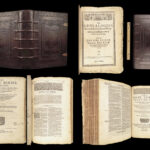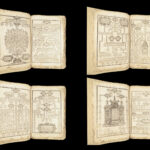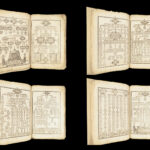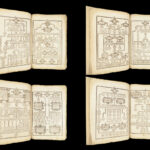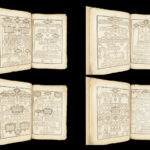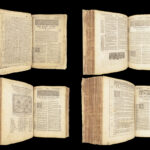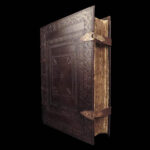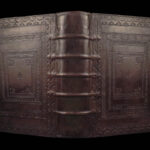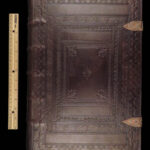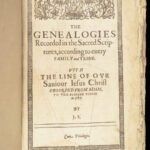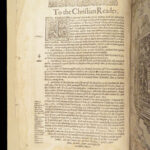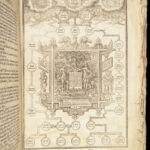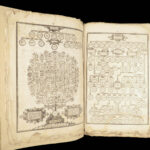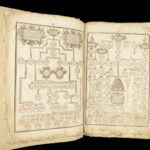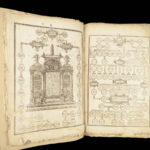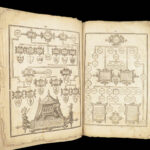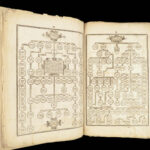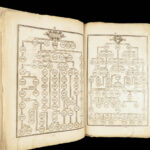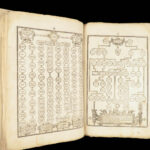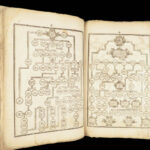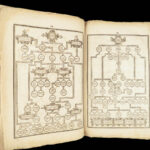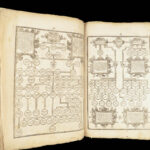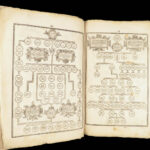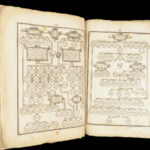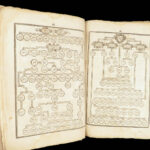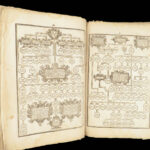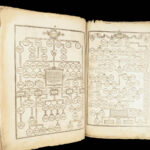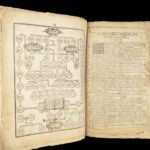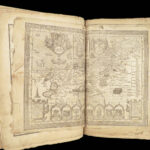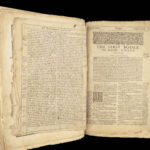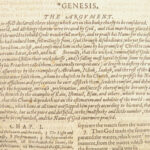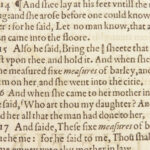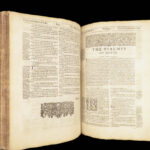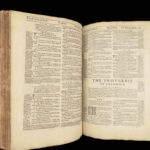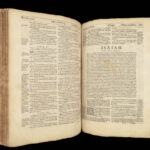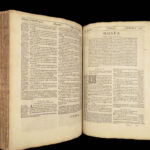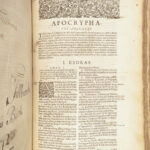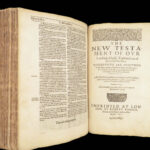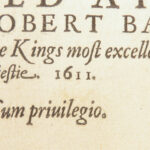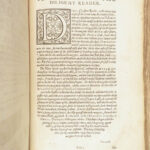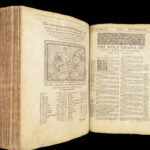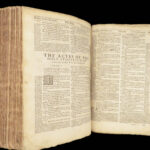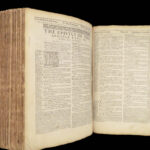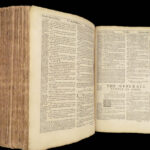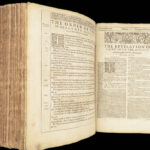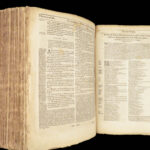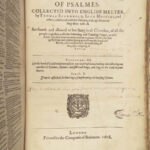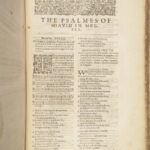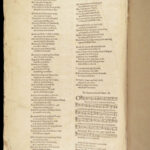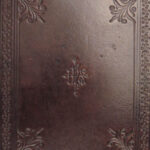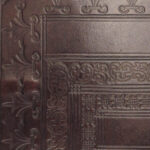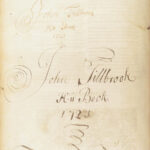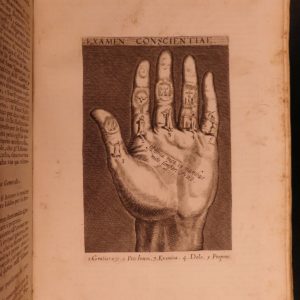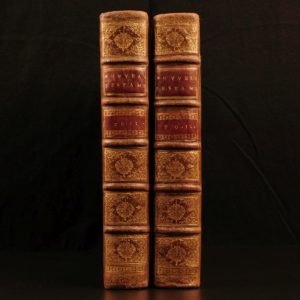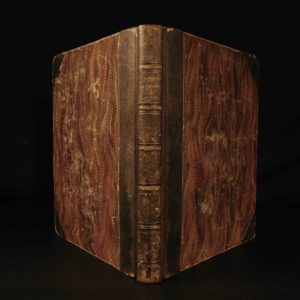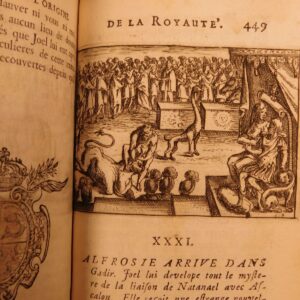1611 King James Geneva Hybrid Bible | 1st ed John SPEED New Testament Genealogy
This King James Geneva hybrid Bible from 1611 to 1618 was printed in London by Robert Barker and associates during a transitional period in English Bible production. In the 16th and 17th centuries, English Bibles printed by Barker were extremely popular and have maintained their value and desirability into the 21st century. However, none are as historically sought-after as the famous 1611 King James Bible. This edition integrates the complete King James Old Testament and Apocrypha with a Geneva-style annotated New Testament. The New Testament title page is present and dated 1611. According to Darlow & Moule, New Testament title pages dated “1611” appeared only in 1611 and 1612 issues; they also state that for editions appearing in 1613, a large portion of the content was probably printed in 1611. Ruth 3:15 reads “she went into the citie,” identifying this copy with the second state of the 1611 King James Bible. Geneva woodcut illustrations, reused from the 1580s to 1590s, are found throughout the Book of Exodus.
The appended metrical Psalter is dated 1618 and printed by Felix Kingston for the Stationers’ Company. It reflects a common practice in Barker’s printshop of incorporating the standard Sternhold and Hopkins Psalms into folio Bibles of the period. The New Testament’s formatting follows earlier Geneva conventions, with double columns of Gothic script, marginal cross-references, and dense annotations attributed to Laurence Tomson, Theodore Beza, Pierre Villerius, and Franciscus Junius. These marginalia provide variant readings from Greek and Latin sources and theological commentary, especially in Revelation. Geneva-style artwork, such as images of Tabernacle furnishings and priestly attire in Exodus, appears throughout this edition and reflects its hybrid construction.
A rare and bibliographically significant early 17th-century folio Bible, printed by Robert Barker ca. 1618, typifying the transitional hybrid editions issued in the wake of the 1611 King James Bible. This example presents a composite construction, combining the newly authorized King James Version text for the Old Testament and Apocrypha, with the enduring scholarly apparatus of the Geneva Bible’s New Testament. The Old Testament includes the corrected reading “she” at Ruth 3:15, identifying the text with the second issue of the 1611 KJV. The formatting follows the 1611 layout with double-column black letter type, chapter summaries, and marginal references, consistent with the design of the authorized version. By contrast, the Geneva New Testament includes extensive annotations and preserved title language such as “Translated out of the Greeke by Theod. Beza, Englished by L. Tomson, with the annotations of Fr. Junius upon the Revelation of Saint John.” Geneva-style woodcuts, reused by Barker, are rarely found in KJV volumes and their inclusion reflects the mixed-format nature of this edition. These composite Bibles emerged between 1613 and 1620, when Barker’s shop continued to use Geneva blocks while transitioning fully to KJV texts. This copy, complete with Psalter and annotated New Testament, stands as a rare artifact from that bibliographic moment.
1611 King James Geneva Hybrid Bible | 1st ed John SPEED New Testament Genealogy
This King James Geneva Hybrid Bible from 1611 to 1618 was printed in London by Robert Barker and associates during a transitional period in English Bible production. In the 16th and 17th centuries, English Bibles printed by Barker were extremely popular and have maintained their value and desirability into the 21st century. However, none are as historically sought-after as the famous 1611 King James Bible. This edition integrates the complete King James Old Testament and Apocrypha with a Geneva-style annotated New Testament. The New Testament title page is present and dated 1611. According to Darlow & Moule, New Testament title pages dated “1611” appeared only in 1611 and 1612 issues; they also state that for editions appearing in 1613, a large portion of the content was probably printed in 1611. Ruth 3:15 reads “she went into the citie,” identifying this copy with the second state of the 1611 King James Bible. Geneva woodcut illustrations, reused from the 1580s to 1590s, are found throughout the Book of Exodus.
The appended metrical Psalter is dated 1618 and printed by Felix Kingston for the Stationers’ Company. It reflects a common practice in Barker’s printshop of incorporating the standard Sternhold and Hopkins Psalms into folio Bibles of the period. The New Testament’s formatting follows earlier Geneva conventions, with double columns of Gothic script, marginal cross-references, and dense annotations attributed to Laurence Tomson, Theodore Beza, Pierre Villerius, and Franciscus Junius. These marginalia provide variant readings from Greek and Latin sources and theological commentary, especially in Revelation. Geneva-style artwork, such as images of Tabernacle furnishings and priestly attire in Exodus, appears throughout this edition and reflects its hybrid construction.
A rare and bibliographically significant early 17th-century folio Bible, printed by Robert Barker ca. 1618, typifying the transitional hybrid editions issued in the wake of the 1611 King James Bible. This example presents a composite construction, combining the newly authorized King James Version text for the Old Testament and Apocrypha, with the enduring scholarly apparatus of the Geneva Bible’s New Testament. The Old Testament includes the corrected reading “she” at Ruth 3:15, identifying the text with the second issue of the 1611 KJV. The formatting follows the 1611 layout with double-column black letter type, chapter summaries, and marginal references, consistent with the design of the authorized version. By contrast, the Geneva New Testament includes extensive annotations and preserved title language such as “Translated out of the Greeke by Theod. Beza, Englished by L. Tomson, with the annotations of Fr. Junius upon the Revelation of Saint John.” Geneva-style woodcuts, reused by Barker, are rarely found in KJV volumes and their inclusion reflects the mixed-format nature of this edition. These composite Bibles emerged between 1613 and 1620, when Barker’s shop continued to use Geneva blocks while transitioning fully to KJV texts. This copy, complete with Psalter and annotated New Testament, stands as a rare artifact from that bibliographic moment.
Item number: #27347
Price: $25,000
Holy Bible
[The Bible : that is, the Holy Scriptvres conteined in the Old and New Testament]
London: imprinted by R. Barker, 1611-18.
Details:
- Collation: text of the Bible entirely complete
- Speed’s “Genealogies” – [2], 34, [4] – complete!
- Wanting general title page and prelims prior to Genealogy
- Fry’s map (from the Speed Genealogies) from a later quarto edition – with shaded sea
- Old Testament / Apocrypha – 444 (i.e., 452) leaves
- Pagination errors expected – entirely complete!
- New Testament – 135 leaves, [14]
- Pagination errors expected – entirely complete!
- Psalmes – [2], 106 (i.e., 108)
- Pagination errors expected
- References: Darlow & Moule 312-353
- D&M 312 – suggests that the 1618 ‘Psalmes’ is correct
- Edition points:
- New Testament title page – dated 1611
- Ruth 3:15 – has “she” instead of “he” – consistent with 1612 printings
- Features the complete Speed “Genealogies”
- Genesis 1 – includes “The Argument”, first appearing in the 1616 small folio; however, this leaf is significantly smaller than subsequent leaves, suggesting it was added later
- Provenance: Handwritten – John Tillman, 1723
- Language: English
- Binding: Leather; tight and secure
- Includes two functional clasps
- Size: ~13.5in X 9.25in (34cm x 23.5cm)
- Speed’s “Genealogies” – [2], 34, [4] – complete!
Our Guarantee:
Very Fast. Very Safe. Free Shipping Worldwide.
Customer satisfaction is our priority! Notify us with 7 days of receiving, and we will offer a full refund without reservation!
Category
Religion
Authors
Holy Bible
Printing Date
17th Century
Language
English
Binding
Leather
Book Condition
Excellent


